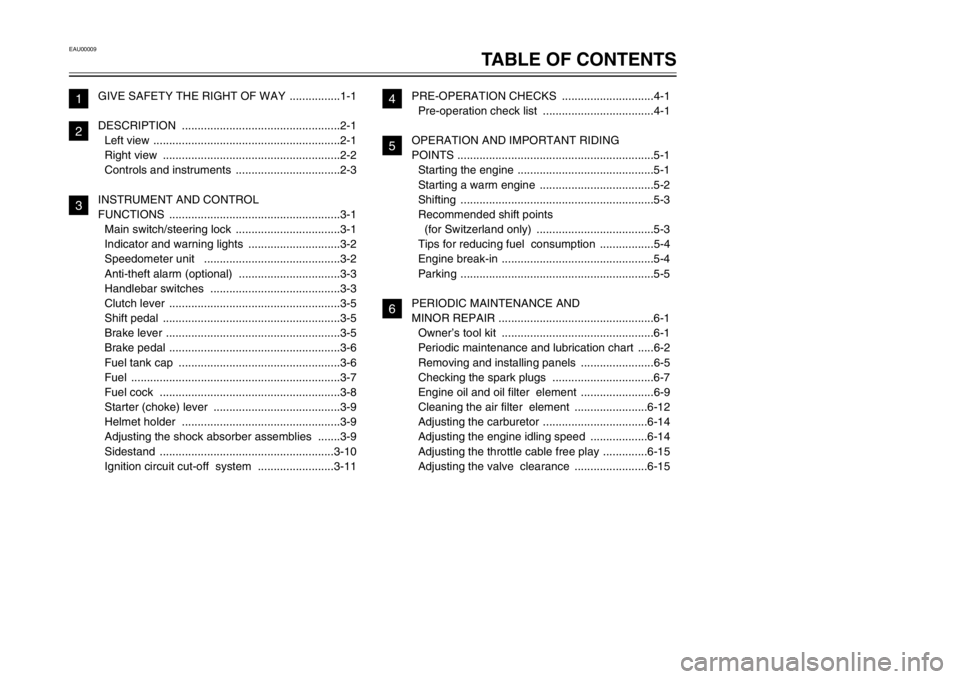lights YAMAHA XVS125 2002 Owners Manual
[x] Cancel search | Manufacturer: YAMAHA, Model Year: 2002, Model line: XVS125, Model: YAMAHA XVS125 2002Pages: 86, PDF Size: 1.63 MB
Page 6 of 86

EAU00009
TABLE OF CONTENTS
GIVE SAFETY THE RIGHT OF WAY ................1-1
DESCRIPTION ..................................................2-1
Left view ...........................................................2-1
Right view ........................................................2-2
Controls and instruments .................................2-3
INSTRUMENT AND CONTROL
FUNCTIONS ......................................................3-1
Main switch/steering lock .................................3-1
Indicator and warning lights .............................3-2
Speedometer unit ...........................................3-2
Anti-theft alarm (optional) ................................3-3
Handlebar switches .........................................3-3
Clutch lever ......................................................3-5
Shift pedal ........................................................3-5
Brake lever .......................................................3-5
Brake pedal ......................................................3-6
Fuel tank cap ...................................................3-6
Fuel ..................................................................3-7
Fuel cock .........................................................3-8
Starter (choke) lever ........................................3-9
Helmet holder ..................................................3-9
Adjusting the shock absorber assemblies .......3-9
Sidestand .......................................................3-10
Ignition circuit cut-off system ........................3-11PRE-OPERATION CHECKS .............................4-1
Pre-operation check list ...................................4-1
OPERATION AND IMPORTANT RIDING
POINTS ..............................................................5-1
Starting the engine ...........................................5-1
Starting a warm engine ....................................5-2
Shifting .............................................................5-3
Recommended shift points
(for Switzerland only) .....................................5-3
Tips for reducing fuel consumption .................5-4
Engine break-in ................................................5-4
Parking .............................................................5-5
PERIODIC MAINTENANCE AND
MINOR REPAIR .................................................6-1
Owner’s tool kit ................................................6-1
Periodic maintenance and lubrication chart .....6-2
Removing and installing panels .......................6-5
Checking the spark plugs ................................6-7
Engine oil and oil filter element .......................6-9
Cleaning the air filter element .......................6-12
Adjusting the carburetor .................................6-14
Adjusting the engine idling speed ..................6-14
Adjusting the throttle cable free play ..............6-15
Adjusting the valve clearance .......................6-15
123
456
5JX-28199-E2 honbun 10/11/01 2:14 PM Page 5
Page 13 of 86

3-2
EAU03034
Indicator and warning lights
Indicator lights
EAU00063
High beam indicator light “&”
High beam indicator light
This indicator light comes on when
the high beam of the headlight is
switched on.
EAU00057
Turn signal indicator light “5”
Turn signal indicator light
This indicator light flashes when the
turn signal switch is pushed to the left
or right.
EAU00061
Neutral indicator light “N”
Neutral indicator light
This indicator light comes on when
the transmission is in the neutral
position.
EAU04243
Engine trouble warning light “”
Engine trouble warning light
This warning light comes on or flash-
es when an electrical circuit monitor-
ing the engine is defective. When this
occurs, have a Yamaha dealer check
the self-diagnosis system.NOTE:
This warning light comes on for a few
seconds when the key is turned to
“ON”, but this does not indicate a
malfunction.
EAU01087
Speedometer unit The speedometer unit is equipped
with a speedometer, an odometer
and a tripmeter. The speedometer
shows riding speed. The odometer
shows the total distance traveled.
The tripmeter shows the distance
traveled since it was last set to zero
with the reset knob. The tripmeter
can be used to estimate the distance
that can be traveled with a full tank of
fuel. This information will enable you
to plan future fuel stops.
INSTRUMENT AND CONTROL FUNCTIONS
3
2040
600
km/h80
100
120140160
12 34
2040600
km/h80
100
120140160
1
23
4
1. High beam indicator light “&”
2. Turn signal indicator light “5”
3. Neutral indicator light “N”
4. Engine trouble warning light “”
1. Speedometer
2. Odometer
3. Tripmeter
4. Reset knob
5JX-28199-E2 honbun 10/11/01 2:14 PM Page 12
Page 15 of 86

3-4
EAU03889
Turn signal switch “4/6”
Turn signal switch
To signal a right-hand turn, push this
switch to “6”. To signal a left-hand
turn, push this switch to “4”. When
released, the switch returns to the
center position. To cancel the turn
signal lights, push the switch in after
it has returned to the center position.
EAU00129
Horn switch “*”
Horn switch
Press this switch to sound the horn.
EAU03890
Engine stop switch “#/$”
Engine stop switch
Set this switch to “#” before starting
the engine. Set this switch to “$” to
stop the engine in case of an emer-
gency, such as when the motorcycle
overturns or when the throttle cable is
stuck.
EAU03898
Light switch “9/
'
/:”
Light switch
Set this switch to “
'
” to turn on
the auxiliary light, meter lighting and
taillight. Set the switch to “:” to turn
on the headlight also. Set the switch
to “9” to turn off all the lights.
EAU00143
Start switch “,”
Start switch
Push this switch to crank the engine
with the starter.
EC000005
cCSee page 5-1 for starting instruc-
tions prior to starting the engine.
INSTRUMENT AND CONTROL FUNCTIONS
3
1
2
3
4
1
2
3
1. Pass switch“&”
2. Dimmer switch“&/%”
3. Turn signal switch“4/6”
4. Horn switch “*”1. Engine stop switch“#/$”
2. Light switch“9/
'
/:”
3. Start switch “,”
5JX-28199-E2 honbun 10/11/01 2:14 PM Page 14
Page 25 of 86

4-2
PRE-OPERATION CHECKS
4
Throttle grip•Make sure that operation is smooth.
•Check free play.
•If necessary, have Yamaha dealer make adjustment or lubricate.6-15, 6-28
Control cables•Make sure that operation is smooth.
•Lubricate if necessary.6-27–6-28
Drive chain•Check chain slack.
•Adjust if necessary.
•Check chain condition.
•Lubricate if necessary.6-25–6-27
Wheels and tires•Check for damage.
•Check tire condition and tread depth.
•Check air pressure.
•Correct if necessary.6-15–6-18
Brake and shift pedals•Make sure that operation is smooth.
•Lubricate pedal pivoting points if necessary.6-28
Brake and clutch levers•Make sure that operation is smooth.
•Lubricate lever pivoting points if necessary.6-29
Sidestand•Make sure that operation is smooth.
•Lubricate pivot if necessary.6-29
Chassis fasteners•Make sure that all nuts, bolts and screws are properly tightened.
•Tighten if necessary.—
Instruments, lights, signals
and switches•Check operation.
•Correct if necessary.3-2–3-4, 6-34–6-37
Sidestand switch•Check operation of ignition circuit cut-off system.
•If system is defective, have Yamaha dealer check vehicle.3-11–3-12 ITEM CHECKS PAGE
5JX-28199-E2 honbun 10/11/01 2:14 PM Page 24
Page 30 of 86

5-4
OPERATION AND IMPORTANT RIDING POINTS
5
EAU00424
Tips for reducing fuel
consumption
Fuel consumption, tips for reducing
Fuel consumption depends largely on
your riding style. Consider the follow-
ing tips to reduce fuel consumption:
8Thoroughly warm up the engine.
8Turn the starter (choke) off as
soon as possible.
8Shift up swiftly, and avoid high
engine speeds during accelera-
tion.
8Do not rev the engine while shift-
ing down, and avoid high engine
speeds with no load on the
engine.
8Turn the engine off instead of let-
ting it idle for an extended length
of time (e.g., in traffic jams, at
traffic lights or at railroad cross-
ings).
EAU00436
Engine break-in
Engine break-in
There is never a more important peri-
od in the life of your engine than the
period between 0 and 1,000 km. For
this reason, you should read the fol-
lowing material carefully.
Since the engine is brand new, do
not put an excessive load on it for the
first 1,000 km. The various parts in
the engine wear and polish them-
selves to the correct operating clear-
ances. During this period, prolonged
full-throttle operation or any condition
that might result in engine overheat-
ing must be avoided.
EAU04399
0–500 km
Avoid prolonged operation above 1/3
throttle.
500–1,000 km
Avoid prolonged operation above 1/2
throttle.
ECA00058
cCAfter 1,000 km of operation, the
engine oil must be changed, and
the oil filter element replaced.1,000 km and beyond
The vehicle can now be operated
normally.
EC000049
cCIf any engine trouble should occur
during the engine break-in period,
immediately have a Yamaha dealer
check the vehicle.
5JX-28199-E2 honbun 10/11/01 2:14 PM Page 29
Page 35 of 86

6-4
PERIODIC MAINTENANCE AND MINOR REPAIR
6
EAU03541
NOTE:
8The air filter needs more frequent service if you are riding in unusually wet or dusty areas.
8Hydraulic brake service
9Regularly check and, if necessary, correct the brake fluid level.
9Every two years replace the internal components of the brake master cylinder and caliper, and change the brake
fluid.
9Replace the brake hoses every four years and if cracked or damaged.19
*Shock absorber
assemblies•Check operation and shock absorbers for oil leakage.√√√√
20*Carburetor•Check starter (choke) operation.
•Adjust engine idling speed.√√√√√ √
21 Engine oil•Change.
•Check oil level and vehicle for oil leakage.√√√√√ √
22 Engine oil filter element•Replace.√√√
23*Front and rear brake
switches•Check operation.√√√√√ √
24 Moving parts and cables•Lubricate.√√√√ √
25*Lights, signals and
switches•Check operation.
•Adjust headlight beam.√√√√√ √ NO. ITEM CHECK OR MAINTENANCE JOBODOMETER READING (× 1,000 km)
ANNUAL
CHECK
1 6 12 18 24
5JX-28199-E2 honbun 10/11/01 2:14 PM Page 34
Page 75 of 86

7-2
MOTORCYCLE CARE AND STORAGE
78Do not use any harsh chemical
products on plastic parts. Be
sure to avoid using cloths or
sponges which have been in
contact with strong or abra-
sive cleaning products, sol-
vent or thinner, fuel (gasoline),
rust removers or inhibitors,
brake fluid, antifreeze or elec-
trolyte.
8Do not use high-pressure
washers or steam-jet cleaners
since they cause water seep-
age and deterioration in the
following areas: seals (of
wheel and swingarm bearings,
fork and brakes), electric com-
ponents (couplers, connec-
tors, instruments, switches
and lights), breather hoses
and vents.8For motorcycles equipped
with a windshield: Do not use
strong cleaners or hard
sponges as they will cause
dulling or scratching. Some
cleaning compounds for plas-
tic may leave scratches on the
windshield. Test the product
on a small hidden part of the
windshield to make sure that it
does not leave any marks. If
the windshield is scratched,
use a quality plastic polishing
compound after washing.
After normal useRemove dirt with warm water, a mild
detergent, and a soft, clean sponge,
and then rinse thoroughly with clean
water. Use a toothbrush or bottle-
brush for hard-to-reach areas.
Stubborn dirt and insects will come
off more easily if the area is covered
with a wet cloth for a few minutes
before cleaning.After riding in the rain, near the sea
or on salt-sprayed roadsSince sea salt or salt sprayed on
roads during winter are extremely
corrosive in combination with water,
carry out the following steps after
each ride in the rain, near the sea or
on salt-sprayed roads.NOTE:
Salt sprayed on roads in the winter
may remain well into spring.1. Clean the motorcycle with cold
water and a mild detergent, after
the engine has cooled down.
ECA00012
cCDo not use warm water since it
increases the corrosive action of
the salt.2. After drying the motorcycle,
apply a corrosion protection
spray on all metal, including
chrome- and nickel-plated, sur-
faces to prevent corrosion.
5JX-28199-E2 honbun 10/11/01 2:14 PM Page 74